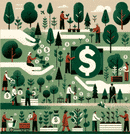News
Successful south-south exchange between Latin American countries on forest degradation monitoring
22/12/2023
22/12/2023

Experts from Argentina, Chile, Colombia, Costa Rica, Honduras, Mexico, and Peru met in the Amazon city of Florencia (Colombia)
Forest degradation generates large carbon emissions (34% of forest sector emissions, FAO 2020). Preventing forest degradation reduces emissions while safeguarding forest ecosystem health and maximizes forest productivity to community livelihoods and the broader economy. Estimating carbon emissions and removals from forest degradation is thus a requirement to participate in new climate finance opportunities.
UN-REDD Programme with the technical support from the United Nations Food and Agriculture Organization (FAO) and the SilvaCarbon program - Latin America and the Caribbean region, brought together 23...
Have your say by 15 Jan 2024: Extended deadline for deforestation-free finance user needs survey
21/12/2023
21/12/2023

The Food and Agriculture Organization of the United Nations (FAO) is conducting a survey open for the participation of respondents from all types of financial institutions and all relevant functions and working levels. The goal is getting information about what frameworks, guidance, and datasets financial institutions use to tackle deforestation in financial portfolios. The survey's results will support the definition of a pathway for mainstreaming deforestation-free finance and enabling financial institutions to improve how to address growing public concern and compliance pressures on deforestation.
Take the survey by 15 January 2024 at https://www.surveymonkey.co.uk/r/faogcsurvey
Respondents: All types of financial institutions from all relevant functions and working...
Into the woods: FAO presents a National Forest Inventory (NFI) e-learning series with digital badge
05/12/2023
05/12/2023

As countries strive to meet international reporting requirements to develop more robust National Forest Monitoring Systems, including reducing emissions from deforestation and forest degradation (REDD+), the importance of National Forest Inventories (NFIs) cannot be underestimated. This systematic collection, analysis and reporting of forest data, plays a pivotal role in providing estimates on relevant variables about characteristics of forests and forested landscapes for a whole country or a subnational administrative or geographic entity, including emission factors for calculating forest-related greenhouse gas emissions and removals. Beyond their carbon-focused function, NFIs provide vital insights into forest biodiversity, health, management, and use, empowering countries...

In the heart of Senegal's picturesque Popenguine Reserve, a group of 50 individuals, armed with cameras and dozens of questions, are slowly moving through the forest and towards the coast. The group – all community-based forestry experts from 15 West African countries and international organizations – stops seeing a group of little egrets (Egretta garzetta) feeding in shallow waters of Popenguine’s sweet water lagoon built by the local community.
The group is guided by a local volunteer and ecoguard Ms Ndeye Ndella NDIAYE who explains that the reserve together with its sweetwater lagoon is the heart of the community and is hosting...
Monitoring gender equality and social inclusion in forest and landscape restoration programmes
05/12/2023
05/12/2023

Global ambition to restore deforested and degraded lands has been increasing over the last decade as people have recognized the important role that healthy lands play in removing carbon dioxide from the atmosphere and mitigating climate change. This increase in global ambition can be seen in the Bonn Challenge, which increased its global restoration goal to 350 million hectares by 2030. However, there is a critical gap in many restoration efforts that many people often overlook. Restoration efforts are often gender blind. While focused on numbers of trees and numbers of hectares, they fail to consider a critical social aspect...

